
The idea of using a color wheel used to make my head spin—remember the old song, Spinning Wheel, by Blood Sweat and Tears? I guess I was intimidated by the concept, as it wasn’t a tool I’d ever used. Remembering how I first felt about them, gave me a reason to research different types and of course costs, and share some simple insights with the pouring community.
When I first ventured into the idea of using a color wheel, I tried a couple of online programs, but they never seemed to work for me; of course that’s because I was using the program wrong. It was simply a monitor color conundrum along with inexperience, you see I was going by the color on my monitor, not relying on the program to give me the correct color. I quickly decided it was just too confusing and dropped the idea all together. I felt lost and totally out of my element.

For years I was too afraid to venture out of my comfort zone. I only used those colors I knew were good together from previous experiences, especially when I got in to poured painting. I was that way for a long time, until I sat down with someone who had a clue how to use a color wheel. She gave me a used one she had and actually worked with me to learn how to use all the wonderful information.
Here are a few tips and insights
No need to spend a lot of money! I purchased this color wheel online for $5.59. I also found this same one on Amazon from different sellers ranging from $5 to $23, so be careful which seller you choose. I must say I really like this particular type: heavy plastic, small enough you can easily manipulate the wheel, but large enough the colors, diagrams, and writing are easy to see.

Computer color wheel applications and tools can be helpful, but don’t try to match up the colors just by visually looking at them. Monitors on your laptops, tablets, and cellphones are all different and the color can vary. These types of electronic tools will give you a visual color, but you must use the color number to obtain the exact color matches. If you are just starting out, like I was, it might be easier to use a simple commercial color wheel. Its tangible, easy to use, and you can see the true colors without trying to match up numbers and names of individual brands.
Take the color wheel to the store with you to choose your colors. I find this extremely helpful. Why you may ask? If, for example, you were to go look for the color Red-Orange in a paint or craft store, it may or may not be the same red orange as it shows on your color wheel. Every brand has its own name for each color and if you want a specific color, your best choice is to take that exact color with you to match up with your paint. Can you pick the correct red-orange from those shown here? I know I wouldn’t be able to without the color wheel in hand.
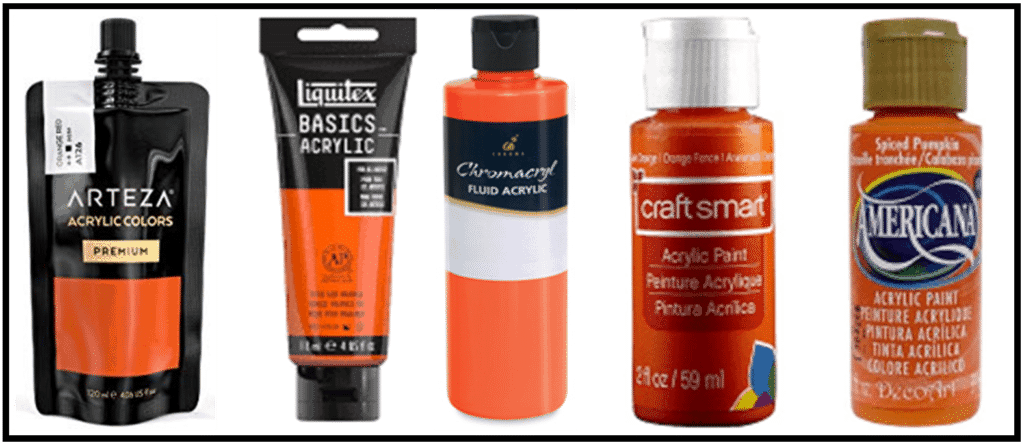
A color wheel is the easiest way to learn how to mix and blend colors too. While it doesn’t tell you how much paint to use, you will always start with the pure color you have chosen on the color wheel, and then slowly add in the second paint (shown in box) until you reach the color, shade or tint you desire.
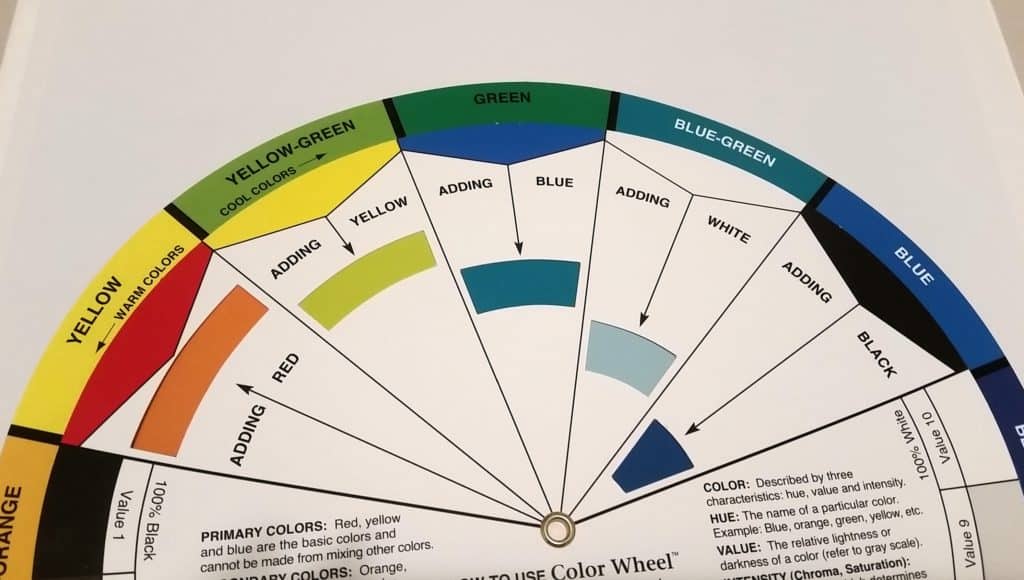
To learn more on blending colors you can read Master the Basics of Color Theory for Harmonious Pours, by Sara Wagner on acrylicpouring.com.
There is nothing better than hands on learning. As a trainer for 16 years before going to nursing school, I worked with adults from all learning levels and across the board, when they could feel and manipulate an item—it sunk in so much faster. I will admit I love this particular item, all the basics are on the wheel—along with what they mean and how to use them. This particular wheel provides hands on, visual colors, written directions, and is an interactive tool. Both sides of the wheel provide an easy to understand guide so you can teach yourself how to use it.
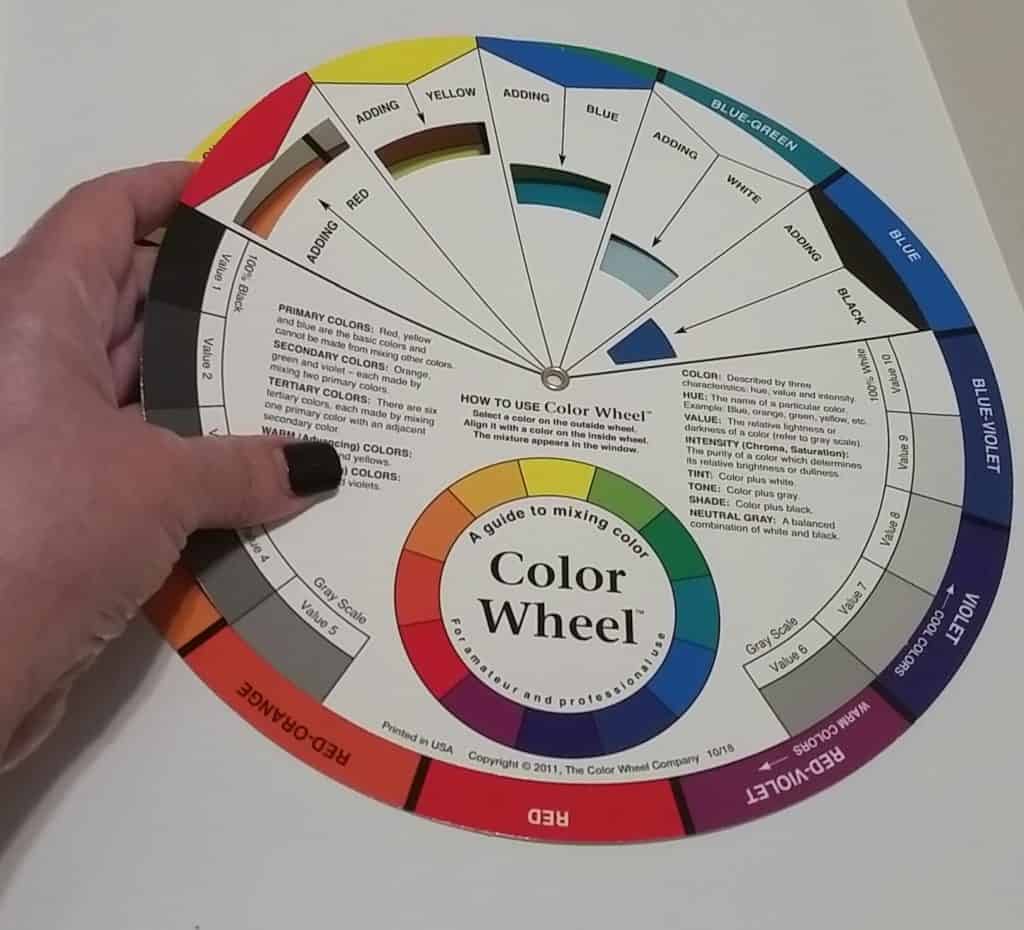
One of the most confusing things for me was the diagrams in the middle of the wheels.
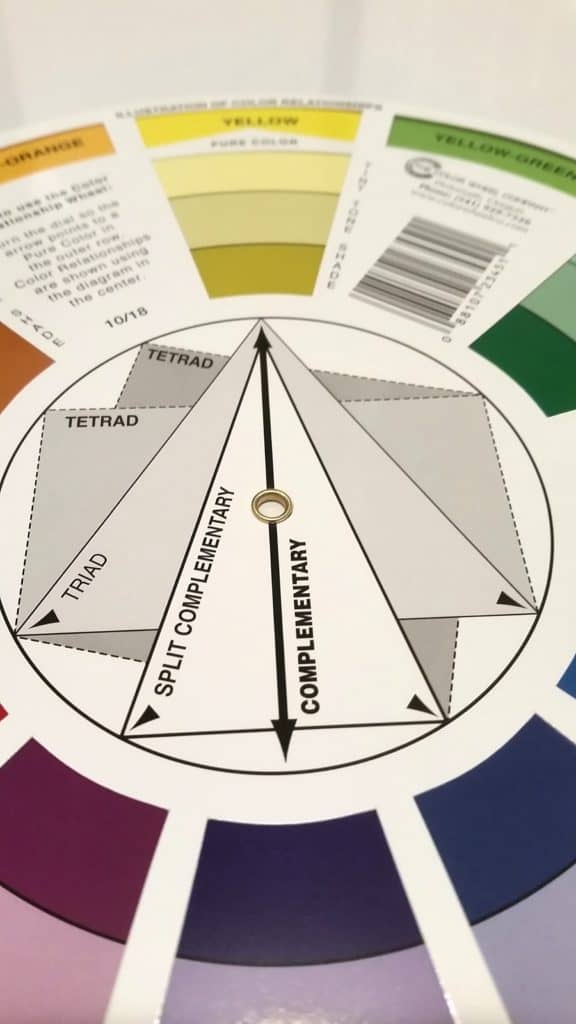
It was just one more layer of information I had no clue about, so one more thing that intimidated me. That is until someone explained it to me in very simple terms. So in turn, I’m sharing this info and when it can easily apply to acrylic pouring. When I discuss these I’m not talking about white or black, just the additional colors you might choose from.
Pouring with 2 colors
Complementary colors are represented by the arrow pointing straight down, the complementary color of red and green.
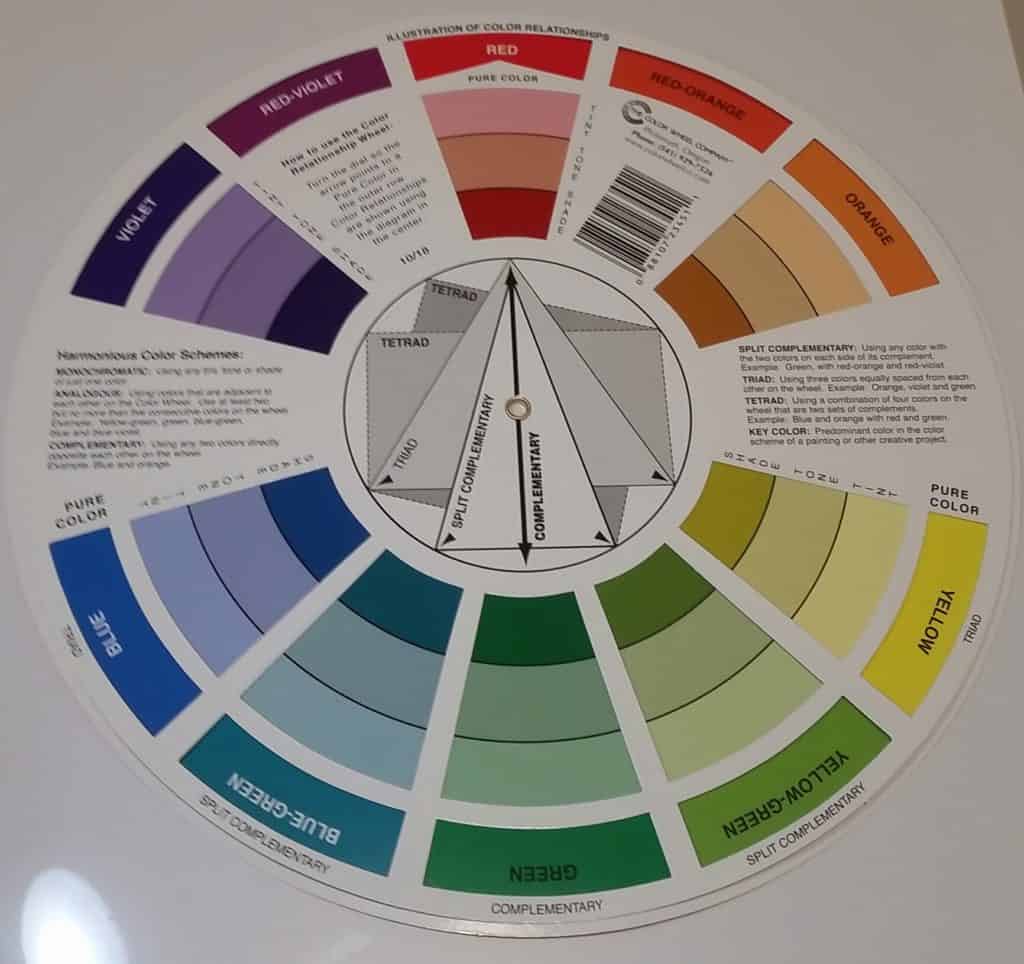
Pouring with 3 colors, option one
Split complementary colors are represented by the narrow triangle on the wheel. The point is always on the pure color, basically your main base color you want to use, and the other two ends of the triangle are the additional complementary colors you can use. Here the split complementary red-orange, blue and green.
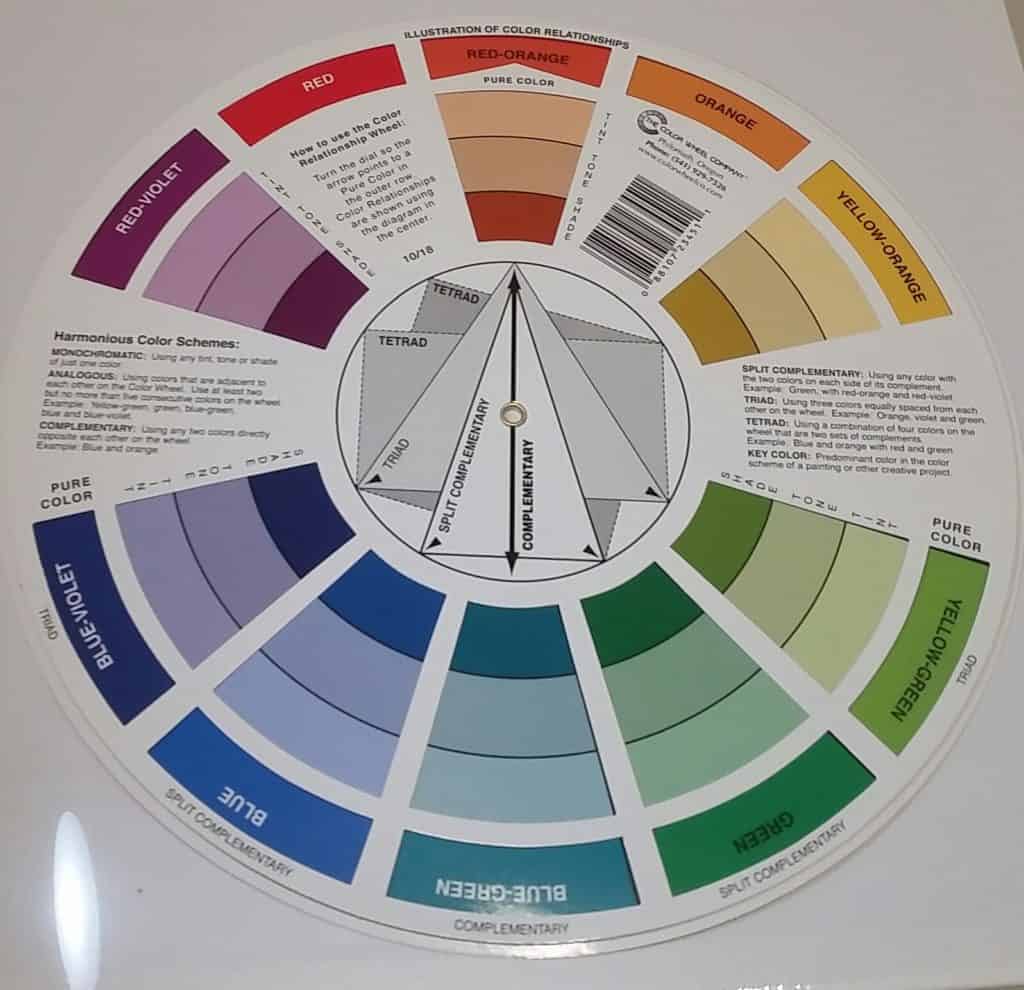
Pouring with 3 colors, option two
Triad is the larger triangle (with equal sides), which gives you three colors with equal space between them on the color wheel. Again point the guide to your pure color choice (your main color: blue-green). Here the triad colors are blue-green, yellow-orange, and red-violet.
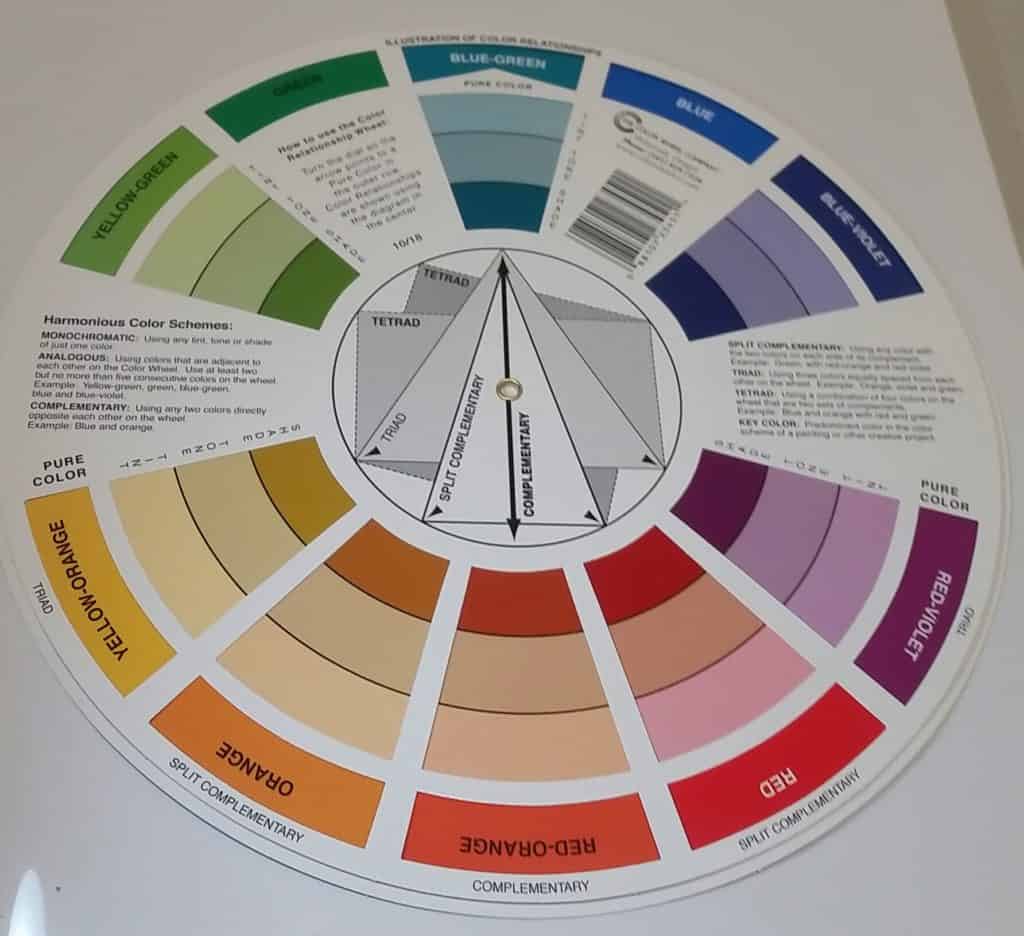
Pouring with 4 colors
Tetrad is the rectangle and square behind the triangles. They give you four complementary colors. It was confusing to me at first, as there are no arrows or points for the initial color you want to use.It’s very easy too, you simply use either tetrad rectangle and put one corner on your initial color you want to use (orange), and magically you have four beautiful colors which complement each other like orange, green, red, and blue.

Hopefully these basics will help you feel more comfortable in choosing and using a color wheel for acrylic pouring. Just for one final piece to inspire—I am showing how I used a color wheel to come up with a color combination I never thought I’d use, especially in pouring projects.

I used the shaded tetrad (square) and the following red, blue-violet, green and yellow-orange. Let me tell you a secret, “I hate yellow-orange” never use it and will likely never use it again. Just for you guys I bit the bullet and did a simple flip cup with silicone in the green only and a dab of white between a few colors. I still hate it as a stand alone, but I have to admit the entire color palette is kinda cool.

Expand your palette and find new inspiration!
Since she began creating art in 2007, Tina Swearingen’s focus has evolved from repurposed conceptual art into the creativity and flow of acrylic pouring. Her pours are inspired by the movement and colors of Southern Arizona’s amazing thunderstorms, and the majestic beauty of the Pacific Northwest, which she now calls home.

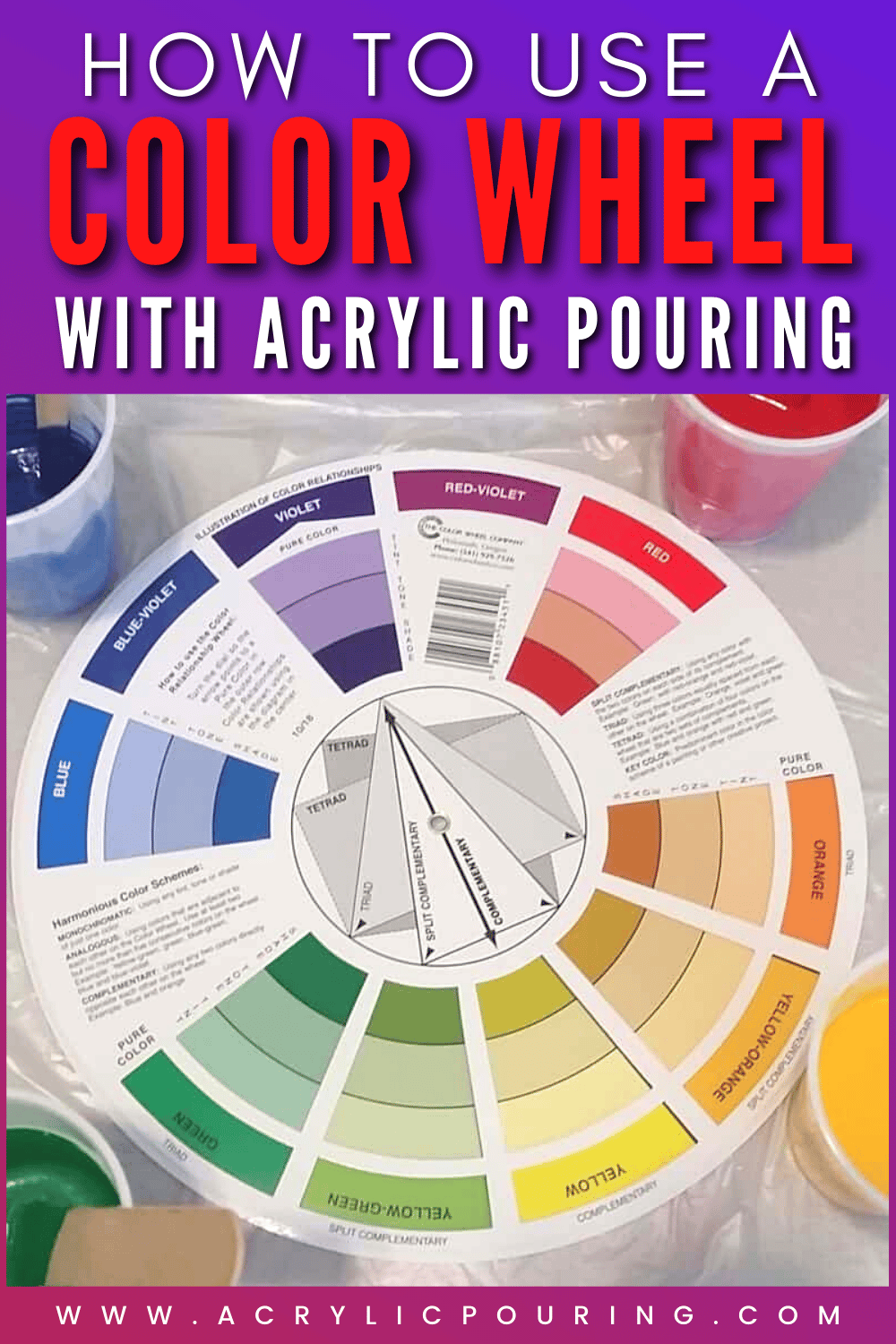
Thanks so much for this info! Will give it a try. ????
Thank you for this article. Very informative because I mix mud sometimes!
Thanks for an excellent little article on colour wheel use. It is comprehensive but short enough to hold one’s attention! I adore colour, which is just one thing I love about “pouring” paint. I can see that theoretically a colour wheel could be useful, although i’m afraid that, rightly or wrongly, half the fun is choosing colours which may, or may not, work!!! Anyway, a very interesting article!
Thanks for explaining a few things that were confusing to me! Tetrad in the shaded were a bit of a challenge, but thanks to you, I can’t wait to experiment!
P.S. I have the same wheel that I got from Hobby Lobby, love it!
Yes, color wheel is the pits to learn, but once you know, you wonder how you did without it. I have used a color wheel for years. It is attached to a wall in my studio, and I spin it whenever I pick colors to achieve a certain mood, etc.
The color wheel article so helpful. Thank u
nice info. another tool is pinterest ~ I’ve collected a couple hundred painting palettes that way for an infinite variety of pours!
I had no clue how to use the color wheel. thank you so much!!
Thank you this does interest me
Thank you!!! That lesson helps!!
I hated the color wheel because i couldn’t figure out how it worked. I couldn’t wrap my head around the points & multiple colors. Thanks to your explanation I now understand.
Easy to understand and very comprehensive post! For me, it’s enlightening!
Good info on using this particular color wheel, but I wasn’t able to figure out how to actually get this one. I assume it’s for sale somewhere, eh?
I bought one just like that at Michael’s.
Thank you for that great advice! I sat here with my wheel, and I like it so much better already! Took away the intimidation factor!
Thank you very much for the information. Finally I can use a Colour Wheel.
Thank you so much for this article which makes using a color wheel completely understandable! I can’t wait to start experimenting using these methods. Up until now I ignored my color wheel because I didn’t know how to apply it to pouring. Thank you again!
Love your info. Great help. I will now use my Color wheel👏💕